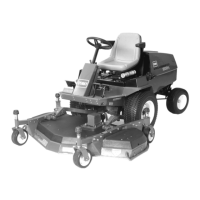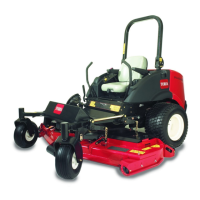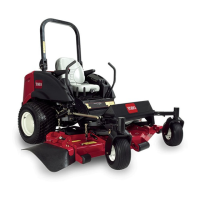22
Changing the Oil Filter
Replace the oil filter every 100 hours or every other oil
change.
Note: Change the oil filter more frequently when operating
conditions are extremely dusty or sandy.
1. Drain the oil from the engine; refer to Changing and
Draining the Oil, page 21.
2. Remove the old filter and wipe the filter adapter
(Fig. 14 and 15) gasket surface.
3. Apply a thin coat of new oil to the rubber gasket on the
replacement filter (Fig. 15).
1256
1
2
3
Figure 15
1. Oil filter
2. Gasket
3. Adapter
4. Install the replacement oil filter to the filter adapter.
Turn the oil filter clockwise until the rubber gasket
contacts the filter adapter, then tighten the filter an
additional 1/2 turn (Fig. 15).
5. Fill the crankcase with the proper type of new oil; refer
to Changing and Draining the Oil, page 21.
Spark Plug Service
Service Interval/Specification
Check the spark plug(s) after every 200 operating hours.
Make sure that the air gap between the center and side
electrodes is correct before installing the spark plug. Use a
spark plug wrench for removing and installing the spark
plug(s) and a gapping tool/feeler gauge to check and adjust
the air gap. Install a new spark plug(s) if necessary.
Type: Champion RC 12YC (or equivalent)
Air Gap: 0.04 in. (1 mm)
Removing the Spark Plug(s)
1. Disengage the power take off (PTO), set the parking
brake, stop the engine, and remove the key.
2. To gain access to the rear spark plug, the gas tank must
be removed (Fig. 16).
Danger
In certain conditions, gasoline is extremely
flammable and highly explosive. A fire or
explosion from gasoline can burn you and others
and can damage property.
• Drain gasoline from the fuel tank when the
engine is cold. Do this outdoors in an open area.
Wipe up any gasoline that spills.
• Never smoke when draining gasoline, and stay
away from an open flame or where a spark may
ignite the gasoline fumes.
3. Rotate the tank and set it in the hood to prevent any fuel
from spilling.
4. Push out the plastic cover from the access hole in the
plate between the engine and gas tank.
5. Pull the wire(s) off of the spark plug(s). Now clean
around the spark plug(s) to prevent dirt from falling into
the engine and potentially causing damage.
6. Remove the spark plug(s) and metal washer.
M–4286
12
Figure 16
1. Fuel tank 2. Opening for access
Checking the Spark Plug
1. Look at the center of the spark plug(s) (Fig. 17). If you
see light brown or gray on the insulator, the engine is
operating properly. A black coating on the insulator
usually means the air cleaner is dirty.
Important Never clean the spark plug(s). Always
replace the spark plug(s) when it has a black coating, worn
electrodes, an oily film, or cracks.
2. Check the gap between the center and side electrodes
(Fig. 17). Bend the side electrode (Fig. 17) if the gap is
not correct.

